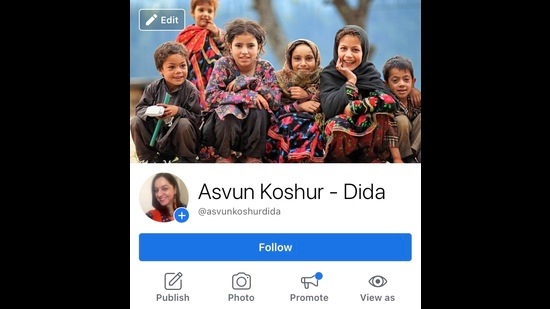A smiling Kashmiri effort: Preaching unity in words and deeds
Meanka Handu’s YouTube channel Asvun Koshur is preserving Kashmiri language with a dose of satire. She’s also reaching out to Kashmiri children from across religious communities, holding virtual sessions that aim to unite.
Meanka Handu was in Class 2 when her family had to leave their ancestral home in Srinagar, to eventually settle in what is now Noida. Their flight was part of the mass exodus of Kashmiri Pandits in the 1990s.

Even at that age, Handu had a sense of what she had lost. She grew up yearning for the Valley. One link with her home state that she clung to was language, but by adulthood she realised that the language she so adored had fewer and fewer speakers, even in Kashmir.
So, in April 2017, she made Kashmiri the focus of her YouTube channel, which she called Asvun Koshur, or A Smiling Kashmiri. For four years, the software engineer with a day job in e-learning has been working to preserve Kashmiri language on Asvun Koshur. Two things set her channel apart: its use of satire in the stories that make up her language lessons; and its attempt to reach out to Kashmiris across religious communities.
“I discuss language and aspects of our culture, to remind my viewers of the harmony in which we all lived once,” Handu says. “For instance, there are days that we celebrate together as Kashmiris and not as a certain religious group, like Badamwari, the festival to welcome Spring.”
To keep it light, Handu, always the family mimic, invented a character through which to speak to her audience. Dida (Kashmiri for elder daughter) is a friendly, straight-forward, liberal and funny mother of two teens. Dressed in traditional attire, speaking the purest Kashmiri she can manage (her parents are regular consultants), she discusses domestic violence, addiction, and the plague of arranged marriages between people who would rather stay single.
The concept has been quite a hit. Asvun Koshur has over 46,000 subscribers. Many of her videos have over 50,000 views. Her biggest hit, a 12-minute take on Dida missing her parents and grandmother and having a tough time with her mother-in-law, has over 1.4 million views. “Math tchuv gatchaan reyi bouk tchunai pheranas manz,” she says of her mother-in-law in that video (roughly: “I’m so annoyed with her that I could put a fistful of ants in her pheran”). Another, titled Masla-e-Shikas-Shuir (Mothers who are worried about the widening generation gap), is about the sadness of having children who are too busy online to communicate with their parents.
The response has been very touching, Handu says. “I wanted people from different religion, who come from this amazing place, to like and appreciate what I’m doing, and my viewers haven’t disappointed me. They realise that what happened in 1990 hasn’t made me bitter.”
As a further step towards her aim of building bridges, Handu has started a series of web posts she calls Asvun Koshur-Zaan (Smiling Kashmiris Getting to Know Each Other), which brings children from across religious communities together online.
“I started it in January, announced it on all my social media platforms. I have a lot of faith in kids, and I believe if you want to teach something positive to people, catch them young. Kids from Classes 1 to 12 are invited from all Kashmiri communities, Pandit, Muslim, Sikh,” Handu says.
In each of these posts (there have been seven so far), two Kashmiri children talk about their hobbies, discuss their traditions and festivals. “In one video, a Kashmiri Muslim girl goes to her backyard in Srinagar and talks about the snow, which was amazing for the Kashmiri Pandit kid, living in Pune and having never seen snow in her life,” Handu says.
In another such session, eight-year-old Namish Kaul from Ghaziabad recited a Kashmiri poem his mother taught him. “Ever since, he’s showing more of an interest in the language,” says his mother, Archana Kaul. “He’s been asking about my childhood, wanting to hear stories about where I grew up.”
Sadly, Handu points out, these sessions have to be conducted in Hindi, because too many Kashmiri children in Kashmir and outside it aren’t fluent in the language.
All Access.
One Subscription.
Get 360° coverage—from daily headlines
to 100 year archives.



HT App & Website






